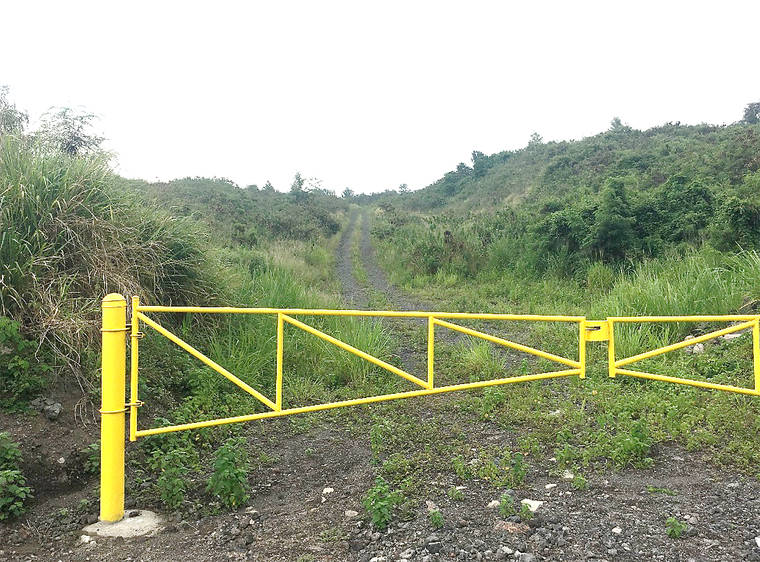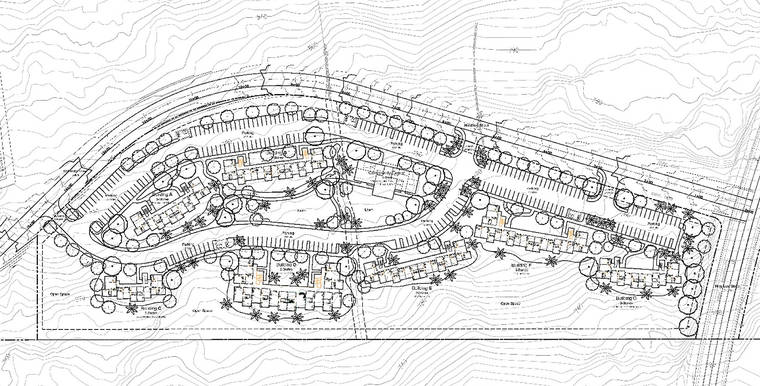Kaloko Affordable Housing Project moves forward


A draft environmental assessment for the Kaloko Affordable Housing Project was released Tuesday, kicking off a 30-day public comment period ending May 23. No impacts to biological, historic, archaeological or cultural resources are expected. (Conceptual plan/from draft EA)
KAILUA-KONA A project that would add 111 affordable housing units to West Hawaii is moving closer to reality.
KAILUA-KONA — A project that would add 111 affordable housing units to West Hawaii is moving closer to reality.
The Kaloko Affordable Housing Project upon completion would build out 111 two- and three-bedroom units on 10.75 acres off Hina Lani Street about 2 miles mauka (east) of Ane Keohokalole Highway.
The estimated price tag for the project is $43.6 million. Construction is expected to start next March with completion slated for August 2021.
A draft environmental assessment for the project was released Tuesday kicking off a 30-day public comment period ending May 23. No impacts to biological, historic, archaeological or cultural resources are expected.
The Hawaii Housing Finance and Development Corporation anticipates a finding of no significant impact for the project being undertaken by the nonprofit Hawaii Island Community Development Corporation.
Since 1991, HICDC has been providing housing for low- and moderate-income residents on Hawaii Island, according to the draft assessment. The nonprofit runs elderly housing projects in Hilo, Waimea, Kohala and Kailua-Kona including Hualalai Elderly Housing off Hualalai Road, said Jeremy McComber, development manager for HICDC.
The Kaloko project will be the nonprofit’s first family rental project, he said.
“We came upon this parcel and evaluated the need in the area, and it just seemed really hard for families to find affordable rentals,” he said. “So we decided to do a family rental project.”
The land was donated by developer RCFC Kaloko Heights to HICDC to meet an affordable housing condition of the development of Kaloko Heights. The acreage is on the makai edge of Kaloko Heights, which calls for 1,300 single- and multi-family homes on about 400 acres.
As currently proposed, the Kaloko Affordable Housing Project could include seven buildings, each two or three stories tall. Construction could occur in two phases, according to the assessment.
Eighty-one units would be finished during the first phase and the remaining 30 during the second phase. Both phases would include two- and three-bedroom units. In all, there would 69 three-bedroom units and 42 two-bedroom units.
Each 750-square-foot unit will be complete with a full kitchen and at least one bathroom, as well as equipped with a range, oven, refrigerator and solar water heating.
A community center will provide on-site property management space, a kitchen, private meeting rooms, communal gathering space, mailboxes and laundry facilities. Outdoor gathering, circulation and play areas, and tenant parking are also planned.
The project will target very low-income households with children. At least 5% of the units would be set aside for eligible families experiencing homelessness, at risk of becoming homeless, or transitioning out of an emergency shelter or transitional housing program. Case management would be offered at the site with an emphasis on financial literacy.
“The reason for that is to help the tenants while they’re there to empower them with what we think are essential skills when they move on,” said McComber, explaining those skills include managing savings and checking accounts and improving credit, among others.
The need for affordable housing in North Kona and South Kohala is high and the project will help to meet that demand, according to the document. An affordable housing unit is defined as a unit with a monthly mortgage or rent that would require no more than 30% of monthly household income.
Median monthly household income for Hawaii County is $53,936 but jumps to $65,682 in North Kona, according to the draft EA.
The median market rent for two- and three-bedroom homes in December 2015 for Hawaii County was $1,554 and $1,771, respectively. In West Hawaii, those rental prices are estimated at $2,168 and $2,456 respectively.
It’s estimated that there are more than 8,000 households within the North Kona and South Kohala districts earning less than 60 percent of the median family income, and over 3,500 households paying more than 30% of their income for rent.
That’s because there are just over 1,000 units within a handful of affordable housing developments in the districts, which have seen increases in population that are expected to continue.
“Vacancies in the affordable housing developments are limited (approximately 1,050 units with very low vacancy) and generally filled with wait lists maintained by the individual projects,” the draft EA reads. “Wait lists for these units are extensive and the State’s Section 8 wait list is so large that it has been closed since 2006. The amount of time for placement in the existing affordable housing units is often more than a year.”
The 2015-16 Consolidated Plan estimated 6,000 families in Hawaii County on the Section 8 wait list with an average wait period of approximately five years. Approximately 1,800 of those families are in North Kona and South Kohala, according to the draft EA.
To date, 75 vouchers have been reserved through Section 8 for the first phase of the Kaloko Affordable Housing Project. The developer is still seeking additional vouchers for that phase, as well as the second phase.
But, “the proposed Kaloko Affordable Housing Project will address only 4 percent of this unmet demand,” the draft EA surmised.
View the draft EA online at https://bit.ly/2WaVf8C. Comments need to be submitted to the approving agency, applicant and consultant, which can be found within the document.


